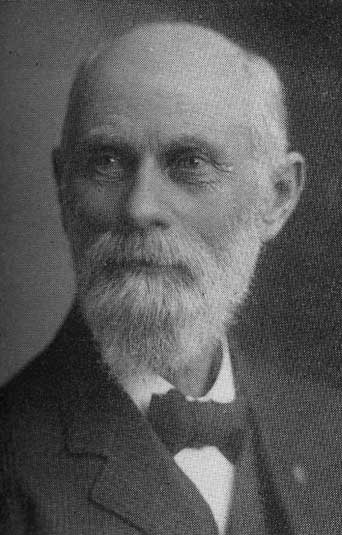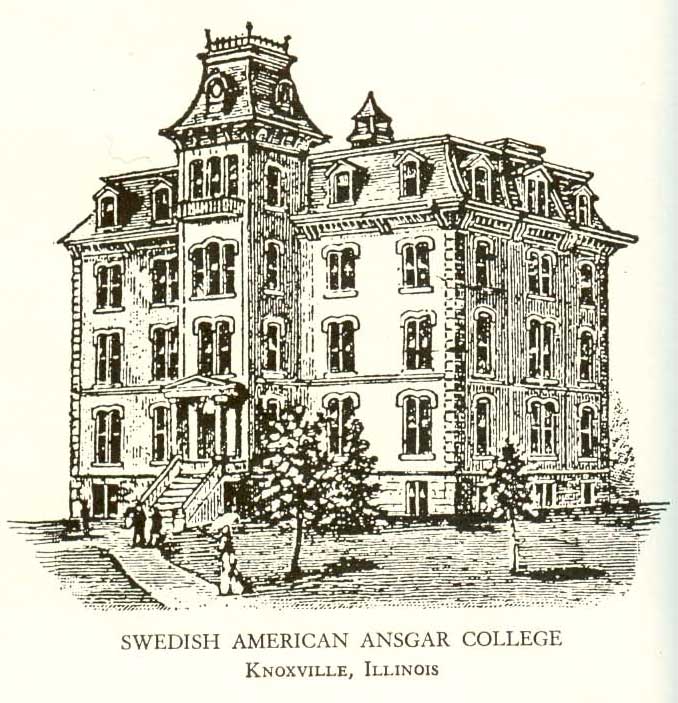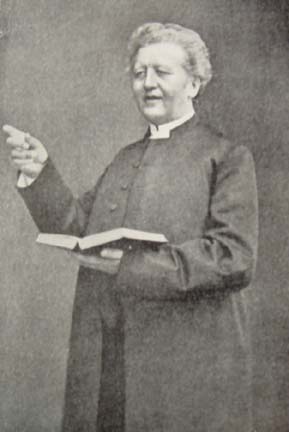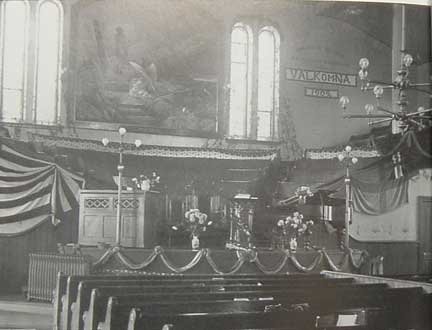That synod only existed for about ten years; 1874 to 1884, so we are looking deep into the faint past. Our guide to the Ansgar Synod story has always been K. Olsson's book," By One Spirit", where he outlines "three synodical ventures"; the Scandinavian Mission Association, the Mission Synod and the Ansgar Synod.


Rev. Charles Anderson, founder of the Ansgar Synod,
and church chairman John Swanson, who wrote to him from Stromsburg
Charles Anderson was probably what we today would call a "progressive". In the Lutheran world of those days, European immigrants from countries with Lutheran state churches were uncomfortable with the American Lutherans. They were speaking "different languages" in more ways than one. The Swedes made some efforts to "link up" with American Lutherans, but soon went in a different direction to form their own synodic organization. That was the story of the Augustana Synod.
But some immigrants, the "progressives" if you will, were inclined to say, "not so fast." There were some things about the Americans, represented locally by the Synod of Northern Illinois, that seemed "okay." The methods of American evangelism with its emphasis on personal conversion was one; increasing acceptance of lay leadership was another. To the Lutherans of Galesburg, the direction of their Augustana leadership seemed too restrictive; too much like "the old country." They sent a delegation to the Augustana annual meeting with some questions: "why must we worship according to the liturgy of the Swedish state church?", "why are the meetings of the clergy closed to laymen?" Even the pastor's apparel was in question. The Galesburg dissenters did not like their pastor wearing the vestments like those of state church priests which they called "dark robes of mourning."
The response from Augustana was a rebuke. And so, the "Second Swedish Lutheran Church of Galesburg" was formed in 1868 by these dissenters. It was one of the four churches reckoned as the first in what would become the Covenant denomination, and its leader was Rev. Charles Anderson. Since the embryonic Augustana Synod was struggling to set its own course in America, it may have tended to over react in some situations like this. Since it had just cut its ties with the Americans of the General Synod and its local body, the Synod of Northern Illinois, it was natural that these rebuffed Americans would give help and encouragement to Anderson and the Galesburg dissenters. Anderson set out to organize a possible "pro-American" alternative to Augustana: it became the Ansgar Synod.


And organize he did. Very soon, with encouragement from the Americans, he founded the first mission friend school in America which became Ansgar College, and the first mission friend newspaper, Zions Baner. It would be interesting to know if that paper, which likely was read in Stromsburg, helped confirm what some of the former Galva people probably already thought, that Anderson and Ansgar were "the way to go." And go they did: Anderson's candidate, C.A. Falk, graduate of Ansgar College and ordinand of the Ansgar Synod became pastor of the Stromsburg Swedish Mission church, and it became a member of the Ansgar Synod.
If Galesburg were the only Swedish center in America there might still be an Ansgar Synod and Stromsburg might still be one of its members. But there were other centers; notably Swede Bend, Iowa, and a place called Chicago, Illinois. Quite a contingent of Swede Bend people traveled down to Keokuk, Iowa, to participate in Rev. Charles Anderson's organizational conference. Others came down from Swedetown Chicago. These folks were mission friends who were having their own issues with the Augustana Synod, but were not ready to be Americanized quite as quickly as Anderson seemed to be. The new Mission Synod which they formed voted Anderson out. (in strict sequence, it was immediately after this that Anderson formed the Ansgar Synod...it had been his intention that the Mission Synod would be "his.")
To make what could be a very long story short, Anderson and Ansgar Synod would wane as the Mission Synod under C. Björk would wax ever stronger. How this impacted Stromsburg is a fascinating question that will involve some speculation. Some very interesting characters emerged in the Ansgar Synod during its brief life, and some even more interesting ideas. One thing can be said with certainty: by the end of Ansgar's life none of the missionfriends were interested in forming another Lutheran Synod. The leader of the mission friends in Sweden, P. Waldenström, had come out against churchly creeds and for a "Biblically based" form of Christianity. The new Covenant of Sweden was rising like the morning sun over the Swedish communities in America.

The ink was scarcely dry on the constitutions of the Mission and Ansgar Synods when some thoughtful persons began efforts to rejoin them. They were too much alike and their constituencies too small to continue to run parallel courses, in spite of the strong "personalities" that seemed to obstruct merger. But changing those constitutions proved the undoing, at least, of Ansgar's college and seminary. They could not revise their documents to uncouple from the churchly creeds without losing title to their school. At least, this is the reason usually given.
It has come to light that Knoxville was experiencing a kind of college frenzy at this time. A book on area buildings reports that no less than six new college buildings were constructed and only one survived. Ansgar College was not alone.
In the death throes of the Ansgar Synod, a proposal was set forth to dissolve completely and reincarnate itself along the lines of the new Covenant of Sweden: not a "denomination" or "synod" but a "mission union" (missionsforbundet). The architect of these ideas was J.G. Princell, recently the president of Ansgar College and currently an editor of Zion's Baner's successor paper, Chicago-Bladet. Princell is reckoned as the leading founder of the Swedish Free Church.
Again in the interests of brevity and with the risk of oversimplification, this innovative "union" idea would not fly with what we have called the "Swede Bend / Chicago" people, the Mission Synod. Much has been made of the issue of requiring a "converted" or regenerate membership on the part of the Mission Synod, something not done by Augustana or Ansgar. The Mission Synod response to an overture for union from Ansgar chided them for this "error in their ways." It was a less than warm response.

Chicago's Tabernacle Church: birthplace of the Covenant
But the rising sun of the Swedish Covenant was flooding the murky landscape of American mission friends, and could not be denied. So, in 1885, when Ansgar, Mission, and independent representatives met in the south side tabernacle that Skogsbergh built, they did set out to form "a more perfect union." And, though it took till 1928, some forty plus years later, the Stromsburg mission friends also joined this union, the Mission Covenant. The Mission Synod had not dissolved; it had joined the union as a body. The new union was too much like a synod to suit professor Princell...he went on to form the Free church.
To expand on the "not so fast" scheme, there are a number of "ventures" to be cited. First, one might group the earliest efforts of the immigrant community to become part of the American church. But first, a bit of ground work.
Two great "movements" must be considered. First, the movement of the Swedish revivals, and secondly the movement of the great emigration to America. Both would figure in the story.
L.P. Esbjorn is counted one of the founders of the Augustana Lutheran church. When he came to America, he was one of the bold leaders who made overtures to the American church: the American Lutherans. He was also committed to the training and education of immigrant ministers and set out to do this at the American's school at Springfield, Illinois. He soon found out that this was not going to work.
The Hedstrom brothers, Olof and Jonas, had come under the influence of American Methodism, and were convinced that this denomination held promise for the newcomers. Through the agency of the welcoming Bethel ship in New York harbor, and a fruitful "halfway house" near the Bishop Hill commune in Illinois, immigrants by the thousands took this route of entry into the American church scene.
Back in Sweden, the influence of the German anabaptist tradition had begun to be felt. G. Palmquist, F.O. Nilsson and A. Wiberg were among the Swedes who embraced regenerate membership, communion for believers only, and believers' baptism. They brought these ideas to America, where Baptists were well established. Thousands more took this route to identify with an American church and their Swedish born denomination endures to this day.
In the American Lutheran context, Charles Anderson had a vision of organizing the mission friend element into a synod more friendly to the Americans than Esbjorn's Augustana Synod had proven to be. He, too, wished to provide training and education for the immigrants which he set out to do at his Mission Institute at Keokuk, Iowa. It soon moved to Knoxville, Illinois, up the river and with the title "Ansgar College."
Each of these ventures sought to become part of the American church scene and each enjoyed the cooperation of their American counterparts. So we group them as one category.
Neither the Baptists nor the Methodists experienced a rupture like this. The Methodists patiently provided a Swedish Conference which in various forms survived until the Swedish language died out. By then, there was integration with the ubiquitous Methodist churches found everywhere. The Baptists were already in the mode of congregational autonomy; after providing an assembly of regional church delegates to charter any new Swedish congregation, that congregation was "on its own." So, we may leave them to the first category in our scheme.
The "not so fast" people were the ethnic and sometimes religious conservatives. Nominally Lutheran, they instinctively held to the "old ways", even if those old ways in Sweden were themselves in a state of flux. When Augustana was chartered, it proved to be the most successful alternative for the immigrants in terms of membership: not thousands, but tens of thousands. It took well over a century, but this synod at last made its peace with American Lutheranism and joined them, first in the LCA and finally the ELCA. "Not so fast" indeed!
Back in Sweden, the revival movement and concurrent social changes were resulting in the formation of independant religious bodies. Remarkably, American mission efforts were bolstering native Baptists and introducing Methodism and even Mormonism among the Swedes. Even the official state church was facing a secession of its mission friends; the Swedish Covenant was being formed.
Now we have the context in which to introduce the American Ansgar Synod and its brief life. Charles Anderson's Scandinavian Mission Synod was to be an American iteration of the Swedish mission friends in organized form. It seemed like a great idea at the time. But it, too, was not going to work. Some of the mission friends from Chicago and Swede Bend, most of them it seems, said "not so fast." They formed the Swedish Evangelical Mission Synod, and left Anderson out of leadership offices.
Because he still embraced affiliation with American Lutherans (the Synod of Northern Illinois) and needed support for his Ansgar College, he along with some like-minded Swedes, then formed the Ansgar Synod. Their center was the school at Knoxville and the nearby Galesburg, Galva and Altona communities. It was this geographic connection which points to Stromsburg's (with roots at Galva) seeking Charles Anderson's recommendation for a pastor. C.A. Falk was the man.
Thus we have the impossible situation of a divided mission friend constituency in America; one that would be resolved nearly a decade later when the American Covenant was formed after the Swedish model. There was only one more complicating factor.
Up in Chicago, the Swedes had chanced to locate in the same neighborhood in which D.L. Moody had built the church which later bore his name. The Moody Bible Institute still stands at that place. Contemporary historian David M. Gustafson has removed any doubt which might have remained concerning the powerful influence of this fact on mission friend history. A strong faction there was emerging which looked upon Augustana, the Mission Synod and the Ansgar Synod, and pronounced a "pox upon all their houses."
Ironically, this group which we have called a faction, was opposing all of the listed bodies for being..."factions." For the immigrants, and particularly for those conservatives of the "not so fast" persuasion, the notion of avoiding religious separatism would have seemed very compelling. The model would have remained the mission associations of Sweden. Would that work in America?
In spite of attracting some of the most talented advocates in thought and journalism among the mission friends (Princell and Martenson), and succeeding in persuading many congregations to form independently of the synods or to withdraw from existing ones, this also did not work. Only when they had changed their initial ideas by incorporating, organizing, and developing a clergy "guild" and even a confessional stance did the group flourish. Today, the (Swedish, but now also Norwegian) Evangelical Free church is the largest among the non-Lutheran immigrant legacy churches.
Joint ventures with Americans:
-Unonius' Episcopal venture*
-Esbjorn's Springfield "experiment"
-Methodist Swedish Conference
-Baptist Swedish General Conference
-Anderson's Scandinavian and Ansgar Synods
The "not so fast" ventures
-Augustana Synod
-Mission Synod
-Mission Covenant
-Free Mission
*Unonius is not treated here, but is an interesting chapter which reminds one of the Delaware Swedish Colony many years earlier. American Congregationalists also wooed the Swedes ardently, but without success.